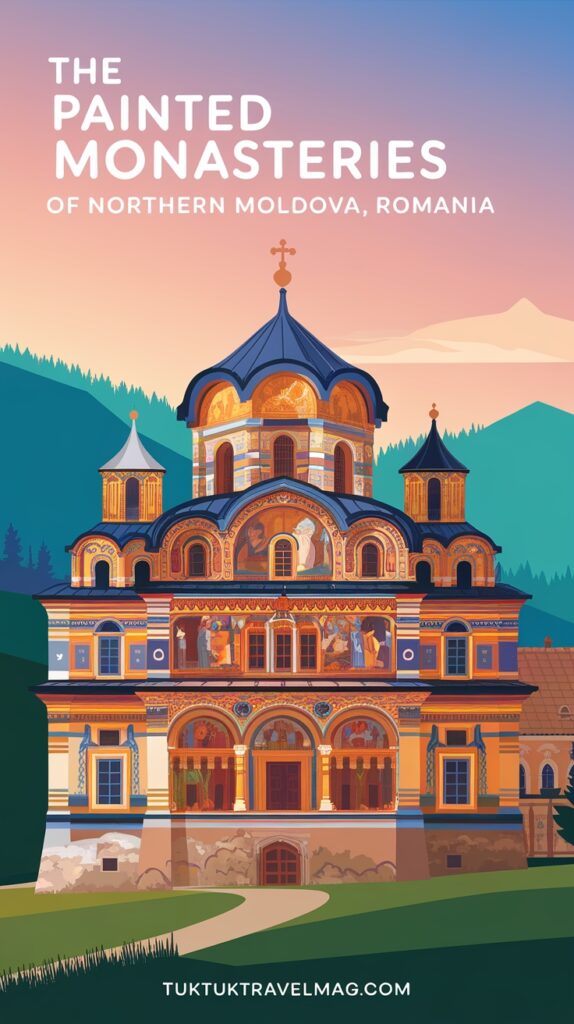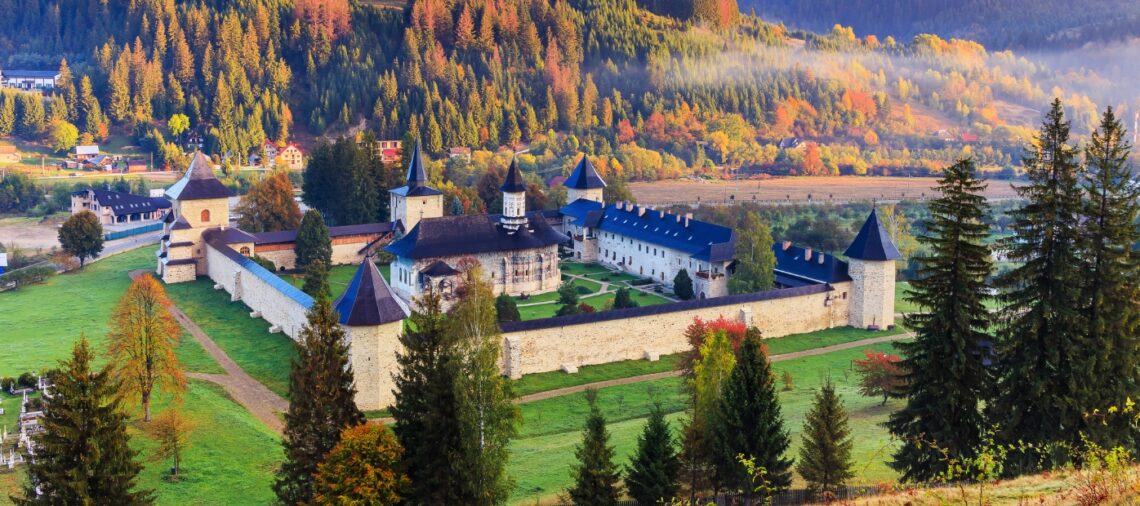The painted monasteries of Northern Moldova, Romania – a region called Bucovina – are a treasure trove of religious art and cultural heritage. Insinuated amidst picturesque landscapes, these monasteries showcase the rich history and artistic prowess of the region. Dating back to the 15th and 16th centuries, the monasteries were founded by Stephen the Great and his successors, Petru Rareş and Petru Rares III, as expressions of their piety and patronage of the Orthodox Church.
The exterior walls of these monastic complexes were adorned with vibrant frescoes depicting biblical scenes, portraits of saints, and military saints. The monasteries played a significant role in the religious and monastic life of the region, serving as centers of spiritual enlightenment and education.
Today, they continue to attract visitors from across the globe, who are captivated by the intricate detailing, vibrant colors, and exceptional craftsmanship of these external wall paintings. Each monastery has its own unique charm and style, but all share a common sense of awe-inspiring beauty. Step into the monastic complex, and you are transported into a world of divine inspiration and artistic mastery.
- History of the Monasteries
- Architecture of the Monasteries
- Exterior Walls and Defensive Towers
- External Paintings and Frescoes
- Mural Paintings Within Churches
- Portraits of Saints and Religious Symbols
- The Monasteries of Northern Moldova, Romania
- Putna Monastery
- Voronet Monastery
- Moldovita Monastery
- Sucevita Monastery
- Humor Monastery
- Dragomirna Monastery
- Conclusion
Travel to Romania? Find the best prices for plane tickets
History of the Monasteries
Stephen the Great and Petru Rareș
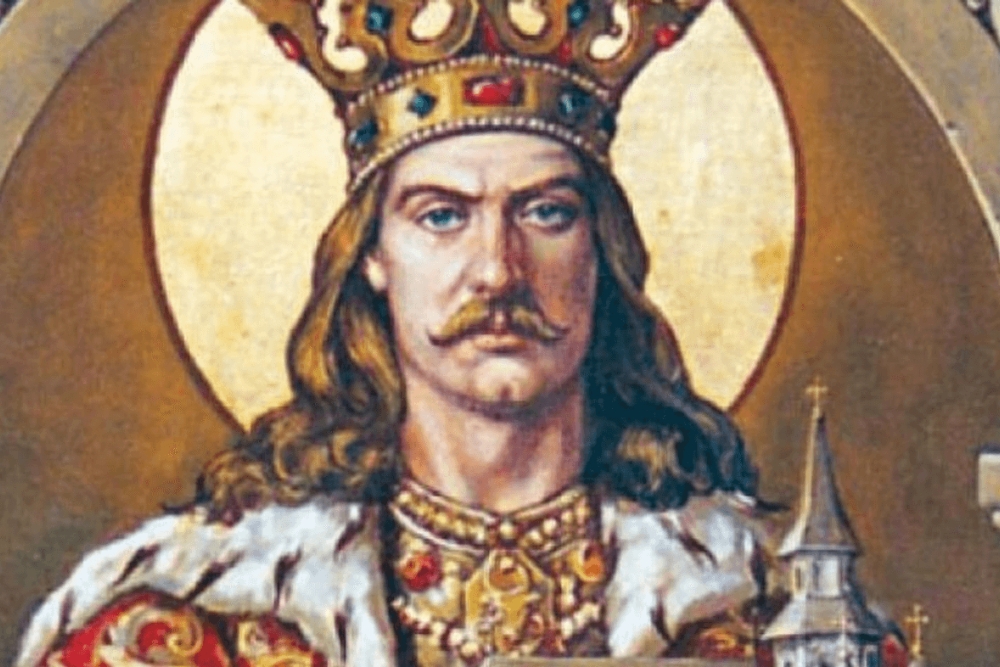
Stephen the Great and Petru Rareș played significant roles in the development, expansion, and preservation of the painted monasteries of Northern Moldova, Romania. Stephen the Great reigned from 1457 to 1504 and was a patron of the arts. Under his rule, the monastic complex flourished in Gura Humorului, Suceava County. He commissioned the creation of several monasteries, such as Humor, Moldovița, Voroneț, and, most important, Putna Monastery.
Petru Rareș followed in Stephen’s footsteps, ruling Moldova from 1527 to 1538 and 1541 to 1546. During his reign, he continued to support the development and preservation of the monasteries. Notably, he sponsored the expansion of Putna Monastery, reinforcing its walls and building a bell tower.
The contributions of Stephen the Great and Petru Rareș extended beyond mere financial support. They actively participated in the painting workshops, contributing to the artistic direction of the frescoes. Many of the monasteries bear their portraits, depicting them alongside religious figures.
These rulers recognized the significance of the painted monasteries as not only sites of religious devotion but also as cultural landmarks. They spared no expense in adorning the exterior walls with vibrant frescoes featuring biblical and religious scenes. Their political spin on these artworks showcased their dedication to the Orthodox Church and their resistance against Ottoman invasions.
During his reign, Petru Rareș undertook ambitious construction projects that aimed to strengthen the monastic complexes. He commissioned the expansion and renovation of existing monasteries such as Putna, Humor, and Moldovița, adding new buildings and fortifications to enhance their defensive capabilities. These defensive measures were crucial in a time when the region faced constant threats from the Ottoman Empire.
In addition to the expansion of physical structures, Petru Rareș also fostered the artistic development of the monasteries. He invited talented painters and craftsmen to create intricate frescoes and exterior wall paintings that adorned the monastic buildings. These exquisite artworks depicted biblical scenes, portraits of saints, and religious symbols, showcasing the deep spirituality and devotion of the rulers and the local population.
The 16th century expansion of the painted monasteries not only resulted in the physical growth of these religious complexes but also had a profound impact on the religious and cultural life of the region. The monasteries became centers of learning and spiritual guidance, attracting scholars, theologians, and monks from far and wide.
The expansion of the monasteries also had a profound effect on the surrounding communities. The influx of pilgrims and visitors brought economic opportunities and trade, leading to the growth of nearby towns and villages. The monasteries became focal points of religious celebrations and festivals, further strengthening the bond between the rulers, clergy, and the local population.
19th Century Decline and Preservation Efforts
However, the 19th century brought significant challenges to the painted monasteries of Northern Moldova. The region faced political instability and foreign invasions, which posed a threat to the existence of these valuable cultural and religious sites. Neglect and deterioration became an unfortunate reality, with the painted frescoes and exterior wall paintings beginning to fade and deteriorate.
During this time, the monasteries struggled to maintain their physical structures and preserve the fragile artworks that adorned them. Without proper maintenance and restoration, the intricate details and vibrant colors of the frescoes were slowly fading away, leaving behind only faint remnants of their former glory. It was an alarming state of affairs for these timeless masterpieces of art and spirituality.
However, in the face of this decline, preservation efforts were initiated to protect and restore the painted monasteries. Scholars, historians, and enthusiasts began to recognize the significance of these unique cultural and religious treasures. Their historical and artistic value prompted the need for urgent action to prevent further deterioration and ensure their long-term survival.
Preservationists worked tirelessly to repair the physical structures, reinforcing the walls and roofs to protect the delicate frescoes from the elements. Measures were taken to stabilize the materials used in the artworks, preventing further decay and loss. Additionally, conservation techniques were employed to restore the faded colors and bring back the original splendor of the paintings.
The preservation efforts extended beyond mere restoration, as educational campaigns were also launched to raise awareness about the importance of the painted monasteries. Local communities were invited to actively engage in their protection and conservation. This grassroots involvement played a crucial role in fostering a sense of ownership and pride in these cultural treasures, ensuring their continued preservation for future generations.
Today, the efforts to preserve the painted monasteries are ongoing. These remarkable sites continue to be protected and maintained, attracting visitors from all over the world who come to admire and appreciate their unique beauty and historical significance. The painted monasteries of Northern Moldova stand as a testament to the devotion, creativity, and resilience of the people who built and nurtured them throughout the centuries.
Architecture of the Monasteries
The painted monasteries of Northern Moldova, Romania are renowned for their unique and breathtaking architecture. Built primarily in the 15th and 16th centuries, these monastic complexes are characterized by their defensive towers, corner towers, and bell towers. The exterior walls of the monasteries are adorned with exquisite paintings, depicting biblical scenes, religious figures, and daily life in monastic communities.
One of the most famous monasteries, Voronet, showcases vibrant frescoes with an abundance of blue, known as “Voronet blue,” created using lapis lazuli. The monasteries also feature intricate woodcarvings, elaborate iconostases, and an outstanding collection of ecclesiastical silverware. The architectural beauty of these monasteries serves as a testament to their historical and cultural significance, attracting visitors from around the world to witness their splendor.
Exterior Walls and Defensive Towers
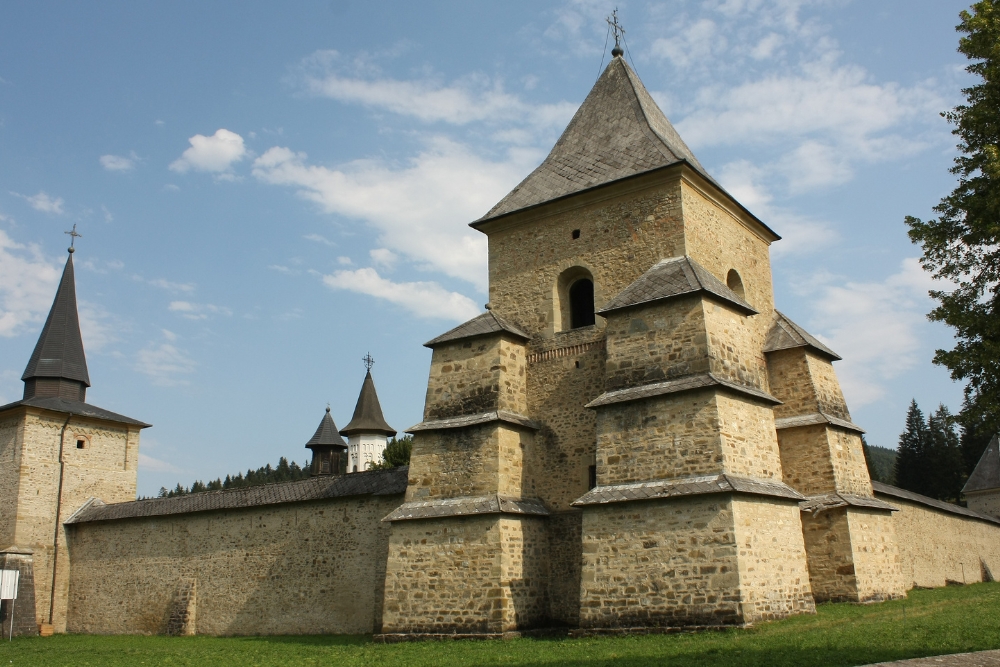
The Painted Monasteries of Northern Moldova, Romania, are renowned for their impressive exterior walls and defensive towers. These architectural elements were constructed during the 15th and 16th centuries and served multiple purposes.
The exterior walls were built to enclose the monastic complex, offering protection and seclusion for the religious community within. Made of stone and designed with precision, these walls were meant to withstand external threats and provide a sense of security. The strategic placement of the corners and towers allowed for better defense against potential attacks.
The defensive towers, located at strategic points along the exterior walls, played a crucial role in safeguarding the monasteries. These towers were equipped with various means of defense, such as loopholes for archers, and were often used as lookout points to detect potential threats from afar.
The purpose of these defensive features was to protect the monasteries from military and territorial conflicts that plagued the region during that time. They served as a physical barrier, deterring potential attackers and preserving the monastic life and religious practices within.
Today, the exterior walls and defensive towers of the Painted Monasteries not only testify to the era’s turbulent history but also contribute to the unique architectural and cultural heritage of the region. Their construction and strategic placement continue to impress visitors, offering an insight into the importance of protection and fortification during that period.
External Paintings and Frescoes
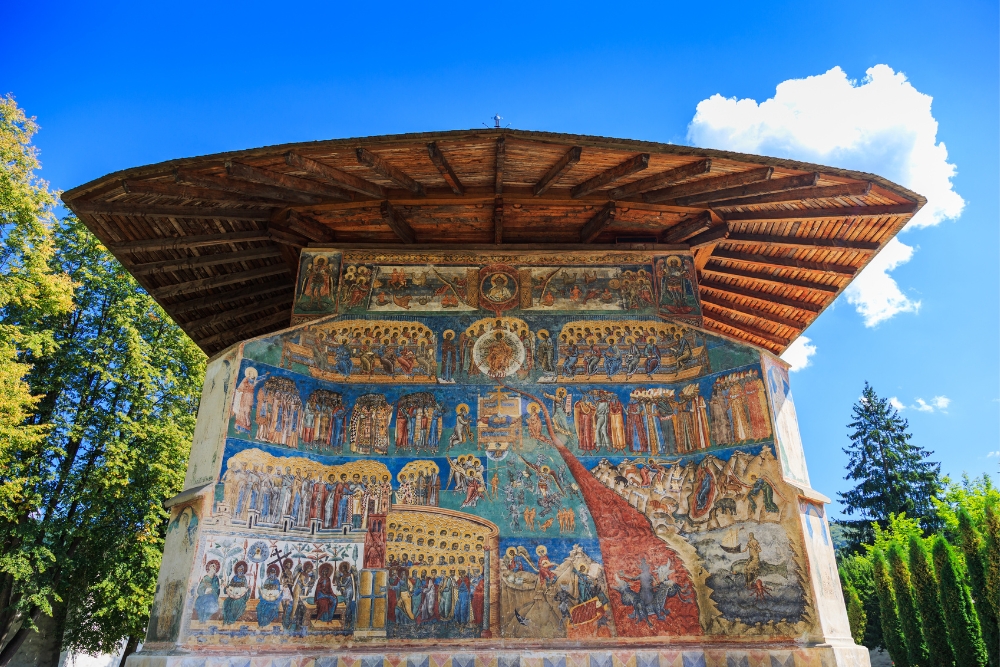
The Painted Monasteries of Northern Moldova, Romania, are renowned for their stunning external paintings and frescoes. Dating back to the 15th and 16th centuries, these vibrant and elaborate artworks adorn the exterior walls of the monasteries, creating a visual feast for the eyes.
The frescoes depict a myriad of subjects, including portraits of saints and prophets, scenes from the life of Jesus, and images of angels and demons. These intricately painted murals serve a dual purpose – religious and educative. Through their vivid imagery, they make biblical stories and the lives of important Orthodox saints known to villagers who may not have had access to written texts.
The external paintings act as visual sermons, communicating religious teachings in a powerful and compelling manner. They bring the divine and the supernatural into the everyday lives of villagers, reinforcing their faith and providing comfort and inspiration.
The meticulous artistry and attention to detail in these frescoes reflect the artistic brilliance of the period. They also demonstrate the unwavering devotion of the artists who dedicated their time and talent to create these magnificent works.
These external paintings and frescoes are not only a testament to the rich spiritual heritage of the Painted Monasteries but also serve as a glimpse into a time when art served not just as decoration but as a medium for religious instruction and inspiration.
Mural Paintings Within Churches
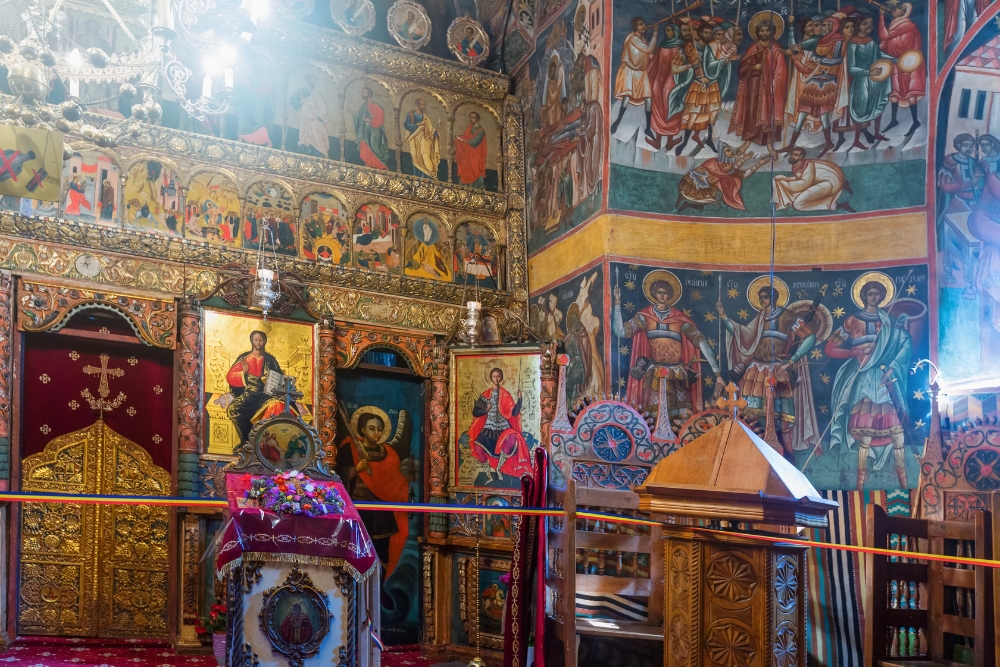
The mural paintings found within the churches of Northern Moldova, Romania, are a testament to the religious devotion and artistic brilliance of the region. These frescoes, with their unique style and significance, depict a wide range of religious scenes and symbols.
The churches’ walls are adorned with scenes from the lives of Jesus, portraits of saints, and biblical narratives. The depictions of these religious scenes serve to educate and inspire the parishioners, bringing the stories of faith to life in vivid color and detail. Symbols such as angels, demons, and heavenly visions are skillfully incorporated into the frescoes, adding to their spiritual impact.
The historical context of these mural paintings is crucial to understanding their significance. Created primarily during the 15th and 16th centuries, the frescoes were commissioned by rulers such as Stephen the Great and Petru Rareș. Their purpose was not only to beautify the churches but also to communicate the teachings of the Orthodox Church to the illiterate congregation.
Artistic techniques such as intricate brushwork, vibrant color palettes, and the use of gold leaf highlight the craftsmanship involved in creating these frescoes. The meticulous attention to detail and the harmonious composition of the mural paintings demonstrate the artistic excellence of this period.
Portraits of Saints and Religious Symbols
Portraits of saints and religious symbols play a pivotal role in the painted churches of Moldavia, Romania. These vivid depictions serve as visual representations of the Christian faith and hold immense importance within the religious art and cultural context of the region.
In the frescoes adorning the walls of these churches, portraits of saints are meticulously painted, capturing the essence and character of these revered figures. These portraits not only honor the saints but also serve as reminders of their virtuous lives and reinforce the principles of the Christian faith. Each brushstroke and color choice convey the individuality and holiness of these holy figures, inspiring the faithful and evoking a sense of reverence.
Religious symbols, such as angels, demons, and heavenly visions, are also skillfully incorporated into the frescoes. These symbols act as visual representations of spiritual concepts and further transmit religious messages. Angels represent divine protection and guidance, while demons symbolize the constant struggle between good and evil. Heavenly visions, such as the Transfiguration or the Assumption, offer glimpses into divine realms and provide spiritual guidance for believers.
In the overall artistic composition, portraits of saints and religious symbols serve as powerful visual aids, creating a sacred atmosphere and inviting contemplation. They provide an intimate connection to the divine and offer spiritual guidance, elevating the worshipper’s understanding and experience of their faith. Within the painted churches of Moldavia, these portraits and symbols stand as testaments to the rich religious heritage and artistic excellence of the region.
The Monasteries of Northern Moldova, Romania
In the northern region of Moldova, Romania (also called Bucovina), there are several magnificent monasteries that have captivated visitors for centuries. These monastic treasures showcase a rich blend of art, architecture, and history that leaves a lasting impression on all who visit. Each monastery has its unique characteristics and stories to tell, from the vibrant exterior wall paintings to the strategic defensive elements. Behind the walls of these monasteries lie skilled craftsmen and artists who dedicated their talents to creating these awe-inspiring masterpieces. Let us explore the beauty and significance of the most important of these monasteries in Northern Moldova.
Putna Monastery
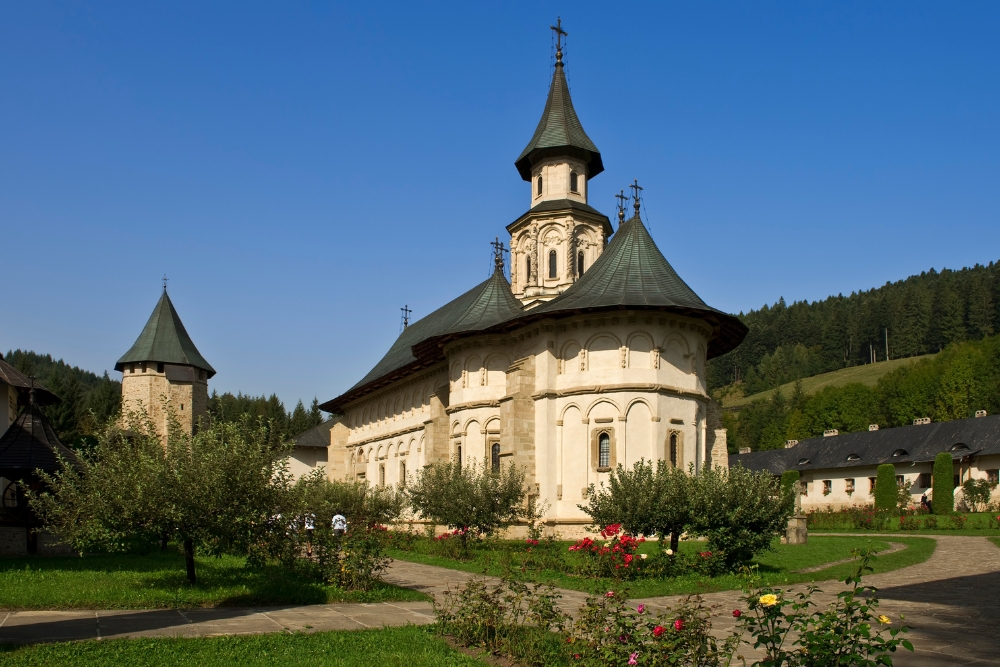
Nestled in the picturesque landscape of Gura Humorului in northern Romania, the Putna Monastery stands as a testament to the rich cultural and religious heritage of the region. Built in the 15th century by Stephen the Great, the renowned Moldavian ruler, this monastery is not only a place of prayer and contemplation but also a treasure trove of exquisite artistic masterpieces.
Putna Monastery was originally intended to serve as a royal necropolis for Stephen the Great’s family, in its functions expanded, being the place where Stephen used to retreat to find peace. For this purpose, a royal house and fortifications were built to protect it against invaders and opportunist thieves.
Here were also set up embroidery workshops for expensive silks woven with gold or silver thread and decorated with precious stones, the book-writing workshop, which had become very famous on the continent, pottery and metal-working workshops and, last but not least, workshops for iconographic painting on glass and wood.
Moreover, there was a school here where people learned reading and writing in Greek and Slavonic, rhetoric, logic, church music and even astronomy, all since the time of Stephen the Great and long after his death on 2 July 1504. Thus Putna Monastery became a remarkable cultural and educational centre, the second most important in the Balkans after the Patriarchal School of Constantinople.
Data about the painting of the Church of the Assumption of the Mother of God of Putna Monastery are available only in chronicles, as the original frescoes were lost with the rebuilding of the holy place in the 17th century.
Voronet Monastery
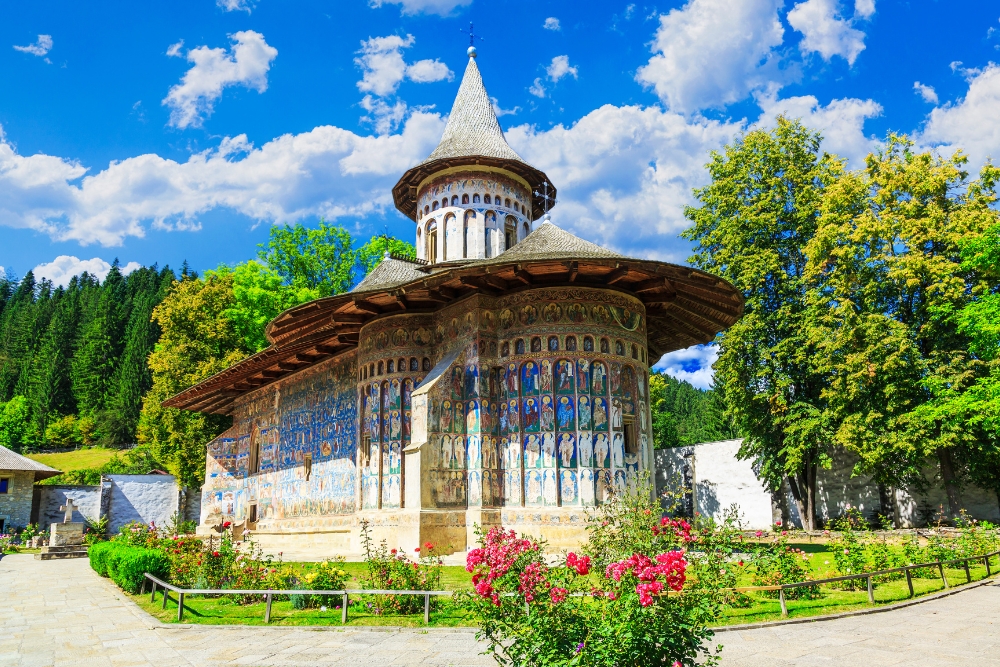
Voronet Monastery holds a significant place among the painted monasteries of Northern Moldova, Romania. Constructed in only 3 months and 3 weeks, in 1488, by Stephen the Great, this religious site has become an emblem of victory over the Ottoman Turks.
The monastery’s construction was commissioned by Stephen the Great to commemorate his successful defense against the Turks. Its distinct conical roof shape, resembling an inverted bell, sets it apart from other monasteries in the region. Cascading down the exterior walls are the famed Voronet blue frescoes, known for their vibrant hues and intricate detailing.
The exterior paintings at Voronet Monastery are truly a feast for the eyes. These masterpieces depict various religious scenes, including biblical stories and portraits of saints. The frescoes are characterized by their intense blue color, achieved using lapis lazuli, a highly-prized pigment.
On the west wall is the Last Judgement, on the south wall: Saint George (the monastery’s patron saint), Genesis, the Altar of the Mother of God and the lives of Saints Nicholas and John the New; and on the north wall: The Vedas of the Air.
The exterior painting, preserved from Stephen’s time, is the work of Metropolitan Grigorie Rosca and several anonymous craftsmen.
The fresco of the Last Judgement on the west wall is so impressive pictorially and theologically coherent that it has come to be compared with Michelangelo’s work in the Sistine Chapel, painted at almost the same time. It is, in any case, the most eloquent treatment of the apocalyptic theme in Eastern Christianity. Its details reveal exceptional esoteric information to which the learned Moldavian monks had access and which they were keen to present to the faithful with a pious respect for the Orthodox canons.
Today, Voronet Monastery stands as a testament to both religious devotion and military prowess. Visitors are mesmerized by the inspiring artwork and the history that surrounds this renowned site. Its significance in Romanian culture and art makes it an essential stop for those seeking to explore the painted monasteries of Northern Moldova.
Moldovita Monastery
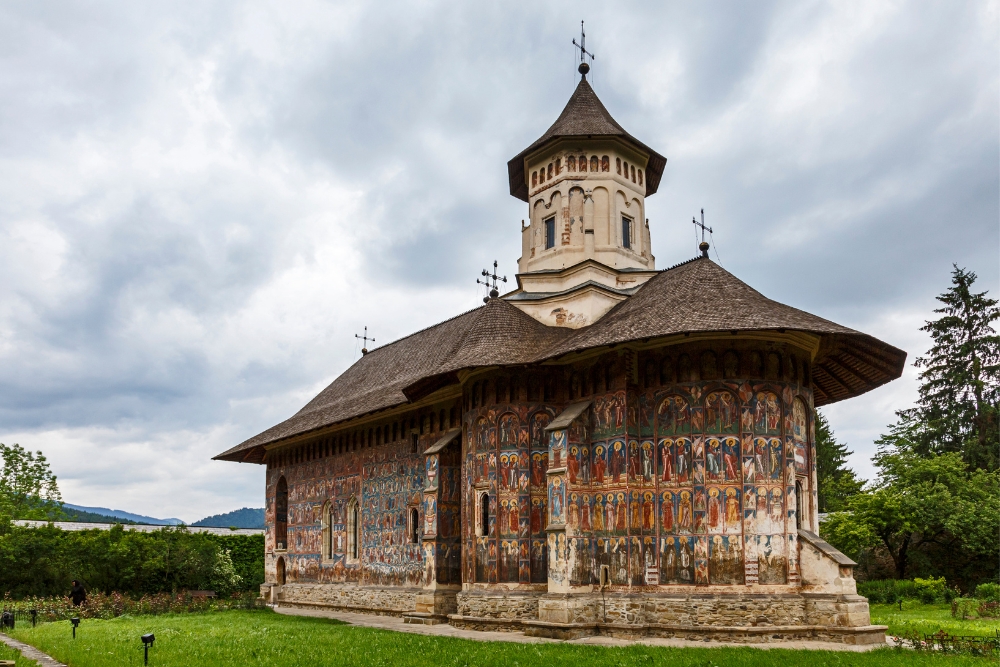
Moldovita Monastery is a historic and architectural gem located in Gura Humorului, Romania. Its construction in 1532 was commissioned by Petru Rareș, the ruler of Moldavia (and step-son of Stephen the Great), as a testament to his power and faith. This magnificent edifice stands out for its unique features, including the vibrant exterior frescoes that adorn its walls, created by the renowned painter Toma of Suceava in 1537.
One of the most striking aspects of Moldovita Monastery is its status as a walled fortress, fortified with imposing corner towers. This defensive design was a response to the constant threats faced by the region during that time. It served both as a place of worship and a stronghold against external forces.
The exterior frescoes of Moldovita Monastery tell captivating stories of religious significance. Among the notable depictions is the famous “Siege of Constantinople,” illustrating the triumph of the Byzantines against the Ottoman Empire. Another remarkable feature is The Last Judgement.
The vibrant external frescoes of Moldovita Monastery, along with its fortress-like architecture, make it a must-visit destination for history and art enthusiasts alike. It provides a glimpse into the rich cultural heritage of Romania and serves as a testament to the enduring artistry and faith of the Moldavian people.
Sucevita Monastery
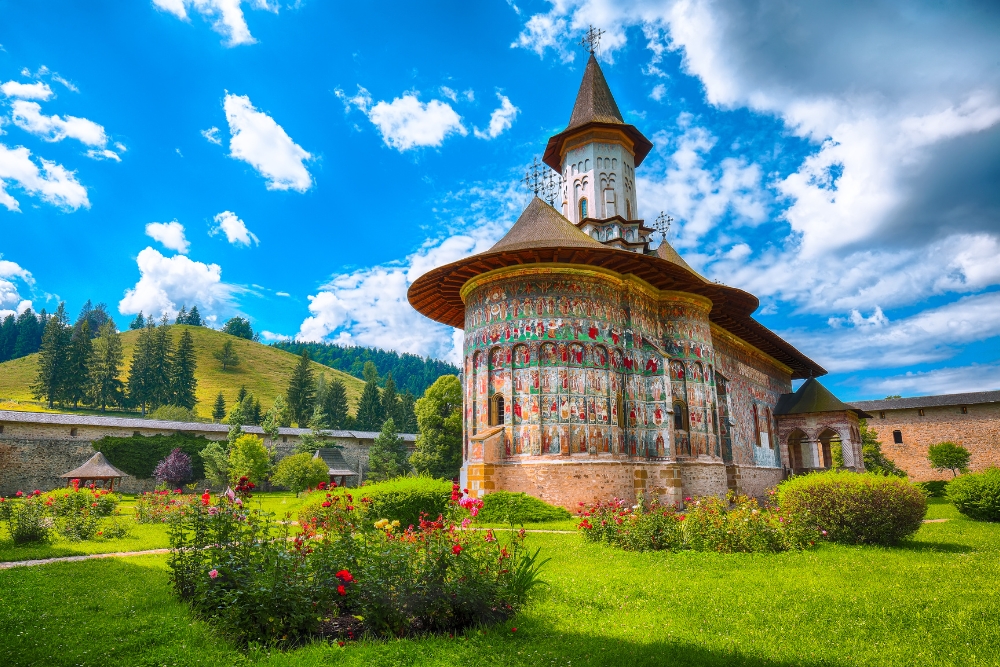
Nestled in the enchanting Bucovina, the Northeastern part of Romania, Sucevita Monastery presents a captivating blend of architectural influences. Constructed between 1583-1586 by Ieremia Movilă and his brothers, Gheorghe Movilă and Simion Movilă, this holy site showcases a harmonious fusion of Byzantine, Gothic, and typical Moldavian styles.
What truly sets Sucevita Monastery apart are its exquisite mural paintings that grace both the interior and exterior walls. These stunning artworks, dating back to 1601, depict a myriad of biblical scenes that transport visitors to a world of religious significance and devotion. Delicate brushstrokes bring to life stories from the Old and New Testaments, meticulously illustrating the lives of saints, miracles, and divine interventions.
Meticulously preserved, these mural paintings capture the essence of Byzantine art, showcasing the mastery of the craftsmen of that time. Vibrant colors, intricate details, and a magnificently preserved palette – all contribute to the breathtaking beauty of these sacred artworks.
Stepping into Sucevita Monastery is akin to stepping into a living gallery of religious history. The frescoes that adorn its walls offer a visual narrative of biblical tales, serving as a constant reminder of the spiritual roots of the monastery and the faith it upholds. In the midst of these awe-inspiring depictions, visitors find solace, inspiration, and a profound connection to the divine.
Humor Monastery
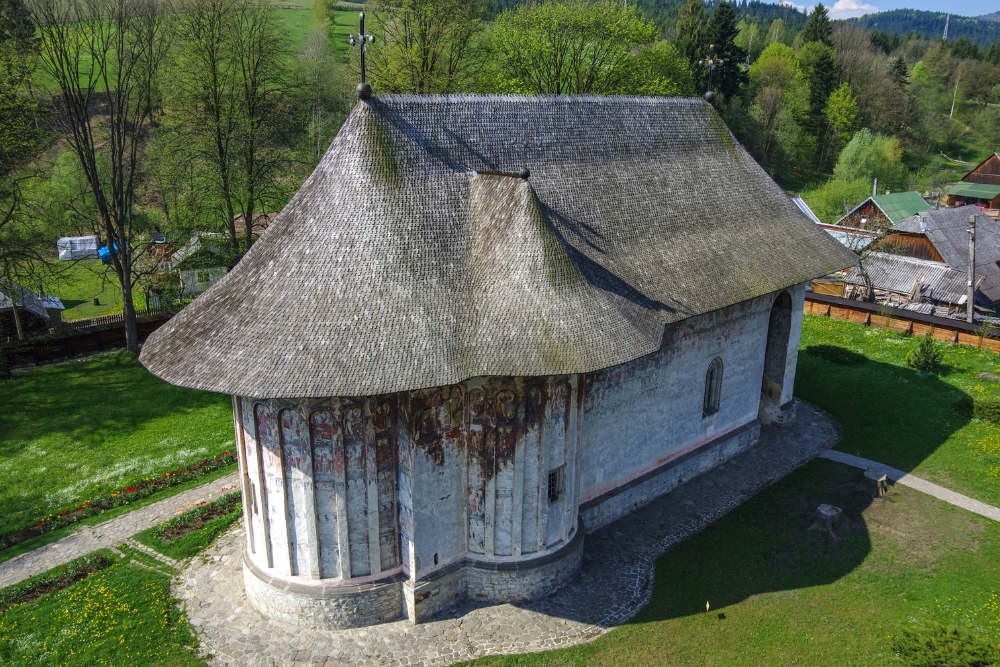
Located near Gura Humorului, Humor Monastery holds significant historical and cultural importance. Founded in 1530 by Voivode Petru Rareș, this monastery is renowned for its unique frescoes that adorn both its interior and exterior walls.
The church of Humor Monastery is, together with the churches of Voronet, Moldovita, Sucevita and Arbore, among the five monasteries decorated both inside and outside with Byzantine frescoes, which make them unique in the Orthodox world.
The interior painting, partially made by “Toma, painter of Suceava” (1535) preserves the iconographic scheme emphasizing the movement and humanism of the expressions. In the pronaos, the paintings depict the ecclesiastical calendar, the icon of the Assumption of the Virgin Mary and the Holy Praying Virgin, angels and prophets. In the tomb chamber, the vault is covered with scenes from the life of the Virgin Mary. The Byzantine icons (16th century), portraits of the founders and tombstones are remarkable. In the nave there are painted figures of saints, the cycle of the Passion and Resurrection, and on the vault, Christ Pantocrator. In the altar, on the apse vault, the Mother of God with the Child is traditionally depicted, together with images of holy hierarchs and the Last Supper.
Dragomirna Monastery
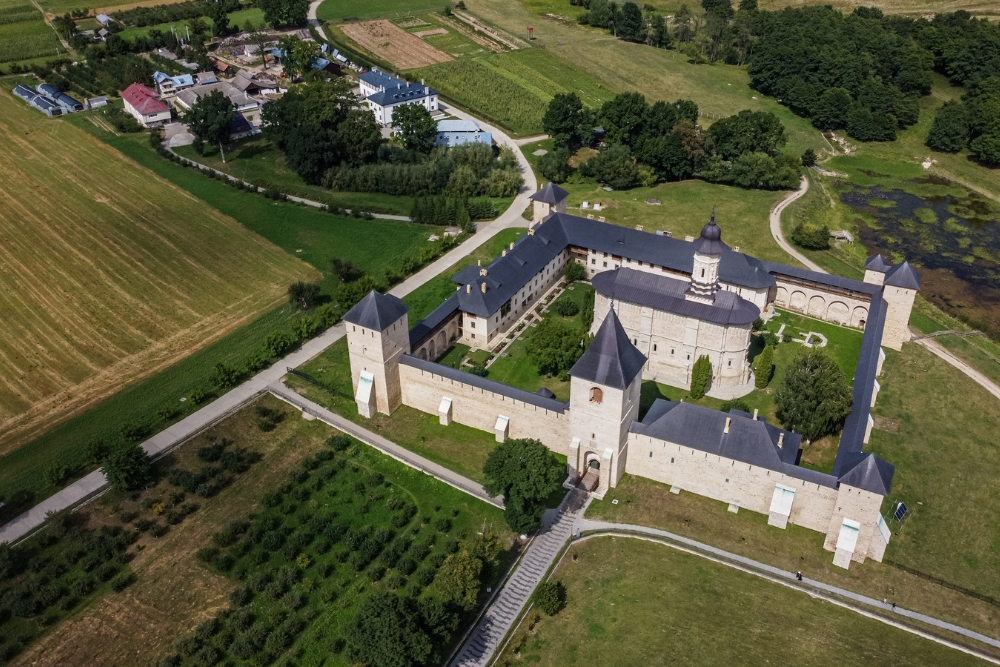
Dragomirna Monastery, also located in Bucovina – Northern Moldova, at 15 km distance from Suceava, is a significant religious landmark rich in history and architectural beauty.
Built by Bishop Anastasie Crimca, in 1609, Dragomirna Monastery is somewhat different from other monasteries in Bucovina, the influences of the early 15th century being evident. First of all, the monastery is very large and it is by far the tallest and narrowest church ever built. Its walls are not painted, but are decorated with stone carvings.
You can climb the walls surrounding the monastery and admire from high up the interior where the nuns carry out all sorts of activities. Dragomirna is located in an extremely quiet area and exudes a contagious peace of mind.
Conclusion
In conclusion, the painted monasteries of Northern Moldova in Romania are a must-visit for anyone interested in history, art, and spirituality. These monasteries, with their rich history and stunning exterior and interior paintings, offer a unique glimpse into the religious and cultural heritage of the region.
Photos: Canva Pro
